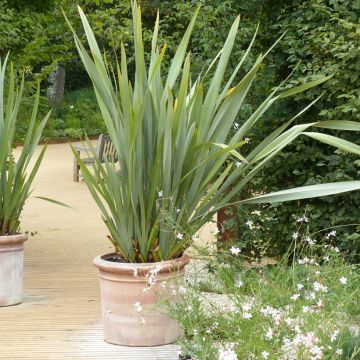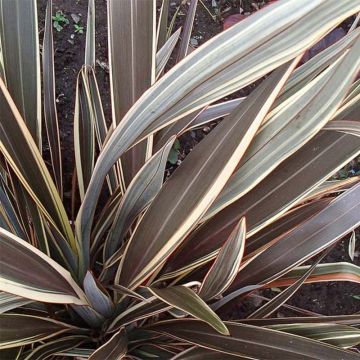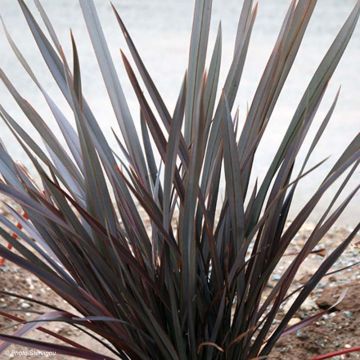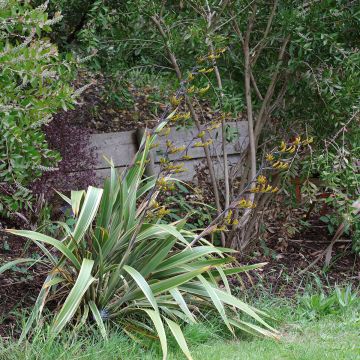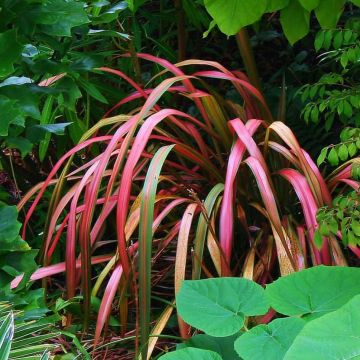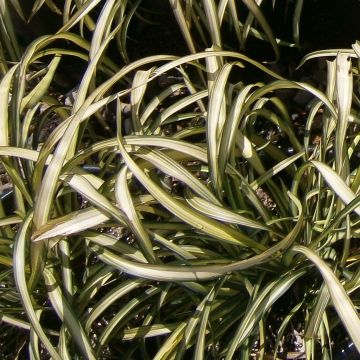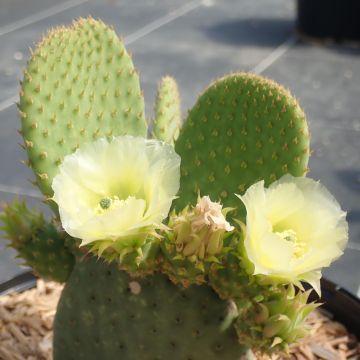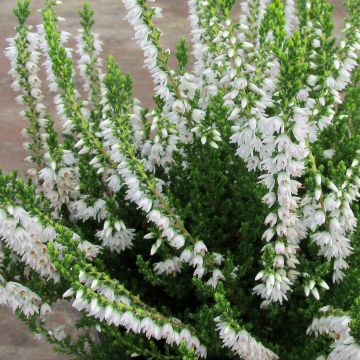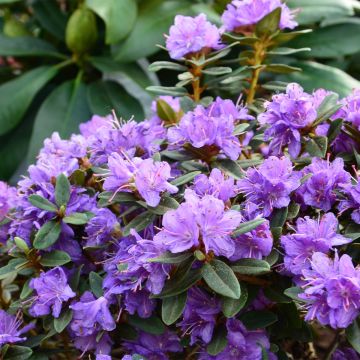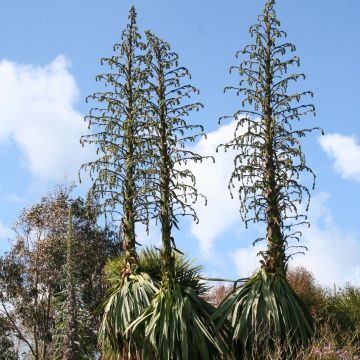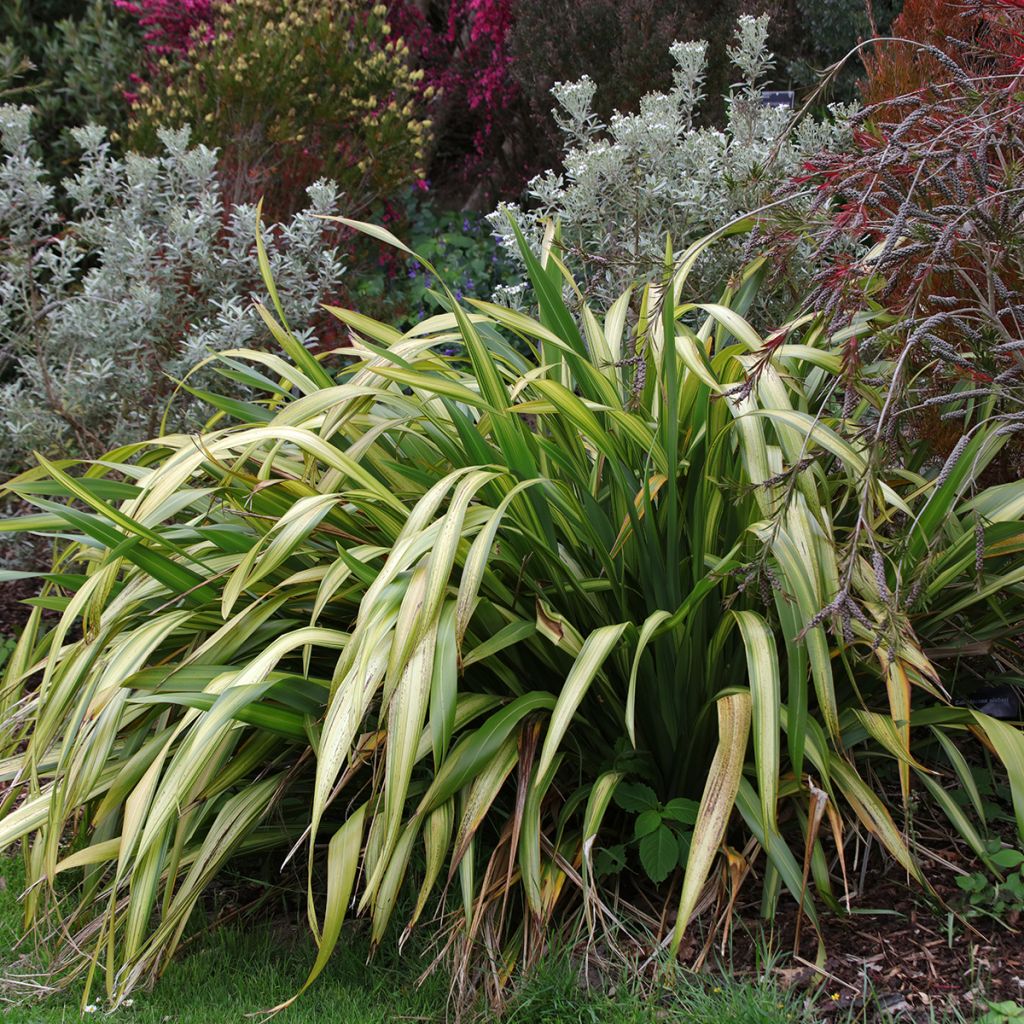

Phormium tenax Yellow Wave - New Zealand Flax


Phormium tenax Yellow Wave - New Zealand Flax
Phormium tenax Yellow Wave - New Zealand Flax
Phormium x tenax Yellow Wave
New Zealand Flax, Flax Lily
This item cannot be shipped to the selected country
Delivery charge from €5.90
More information
Schedule delivery date,
and select date in basket
This plant carries a 12 months recovery warranty
More information
We guarantee the quality of our plants for a full growing cycle, and will replace at our expense any plant that fails to recover under normal climatic and planting conditions.
From €5.90 for pickup delivery and €6.90 for home delivery
Express home delivery from €8.90.
Does this plant fit my garden?
Set up your Plantfit profile →
Description
Phormium tenax 'Yellow Wave', forming a large dense clump with a slightly spreading and disheleved habit, surprises with the brightness and size of its foliage which uniquely dresses a bed or terrace, becoming the centrepiece. Its leaves, wide, linear, slightly arched, resemble long ribbons of soft yellow satin with long green stripes. This wonderful variety is unfortunately not very hardy. It prefers mild climates and non-calcareous soils from the Atlantic coast to the Mediterranean, which is too dry in summer. It will also thrive in a large container, to be overwintered in a cool climate.
Phormium tenax 'Yellow Wave' belongs to the Agave family. It is a horticultural cultivar derived from Phormium tenax, the larger of the two New Zealand species. This superb rhizomatous perennial grows in a large, non-invasive clump. It has an upright and arching habit, reaching about 1.5m (4ft 11in) in height and 1m (3ft 4in) in width at maturity, quite rapidly, depending on the growing conditions. The leaves are very wide (10cm (3.9in)), linear, arched, very long, quite flexible, and pointed at their tips, remarkably variegated. Their colour, varying from one to another, is a light green-yellow to cream-yellow, irregularly but invariably crossed and widely edged with lines of medium green, from the base to the tip. While the foliage is the main asset of this perennial, its flowering, when it occurs, is not to be ignored. Thick flowering stems, at least 2m (6ft 7in) tall, appear from May to July, depending on the climate, overhanging the clump of foliage. They are green tinged with purple, in the form of curved flower spikes, 5cm (2in) long, which turn a matte red colour when ripe. This flowering attracts certain birds and numerous pollinating insects.
This Phormium is a plant of great ornamental value, suitable for large beds or rock gardens in mild climates. It can sometimes be disappointing in a Mediterranean climate, which is too dry, as well as in overly calcareous soil, but it is magnificent in temperate maritime climates. Used as a specimen or planted in groups, it structures the space and gives a completely exotic charm to the garden. Like tall grasses, it is also a wonderful perennial for a modern garden with clean lines, adorned with bamboo. In cold regions, it can be planted in a very large wooden pot or, why not, in raw concrete, on the terrace or balcony. Its elegance can be admired during the beautiful season, without forgetting to overwinter it frost-free, in a cold greenhouse or a minimally heated conservatory. In an urban garden, it softens concrete structures and is enhanced by a gravel mulch. In a more classic setting, colourful Cordylines and evergreen shrubs with purple foliage, such as Pittosporum 'Tom Thumb' or Lophomyrtus 'Magic Dragon', will form a beautiful backdrop for its luminous foliage.
The Maoris use Phormiums as we use linen, for their fibres which are used in the textile industry. This ability probably explains their vernacular name of 'New Zealand Flax' or 'Mountain Flax'.
Report an error about the product description
Phormium tenax Yellow Wave - New Zealand Flax in pictures
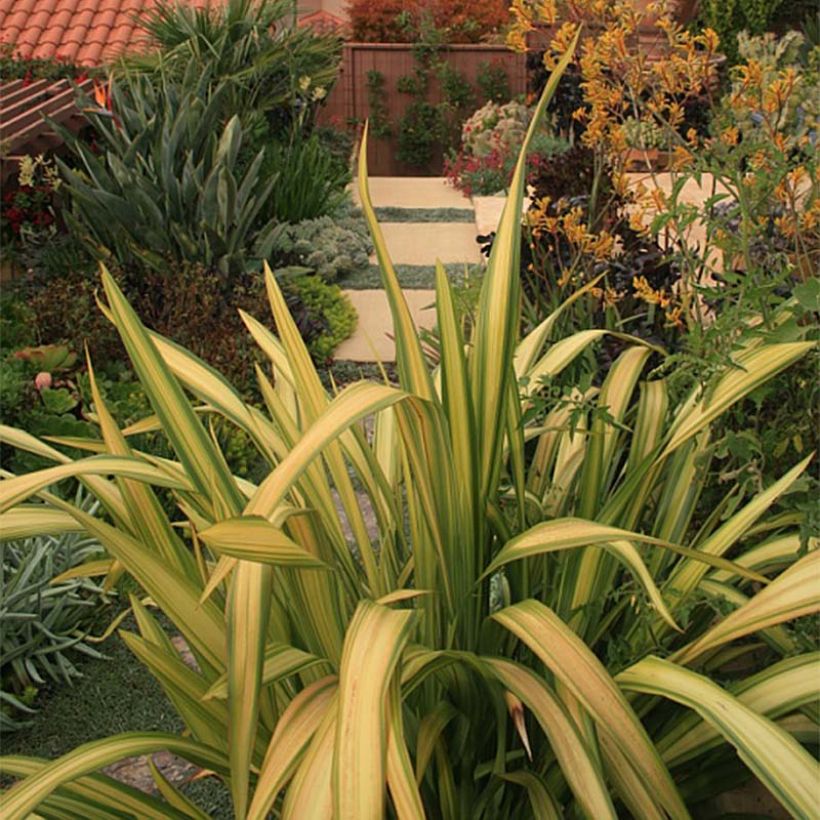



Flowering
Foliage
Plant habit
Botanical data
Phormium
x tenax
Yellow Wave
Agavaceae
New Zealand Flax, Flax Lily
Cultivar or hybrid
Other Phormium
Planting and care
Phormium 'Yellow Wave' is a hardy plant that will primarily be grown in open ground in regions where temperatures do not drop below -5°C (23 °F). In all other areas, pot cultivation is more suitable, allowing for winter protection from frost in a cool and bright room.
Plant your Phormium in a container or large pot with a bottom layer of gravel, broken pottery shards, or clay pellets. The soil mix should be fertile and well-draining (1/3 leaf compost, 1/3 compost, and 1/3 regular garden soil, enriched with a handful of crushed horn).
Place the plant in full sun. Water generously during the growing season to ensure the soil never completely dries out. Feed the plant with "special green plant" fertilizer diluted in water once a month. In winter, reduce watering and fertilizing, and allow the soil to dry superficially between waterings.
In regions with mild climates and light frosts, plant your Phormium in well-draining but cool and fertile soil in open ground, exposed to full sun.
In summer, make sure the plant doesn't lack water. In winter, it can rely on rainfall.
In case of severe frost, apply a thick layer of mulch around the base of the plant and cover it with a winter veil.
In the coldest regions, a thick mulch will help protect the roots from freezing in winter.
Planting period
Intended location
Care
-
, onOrder confirmed
Reply from on Promesse de fleurs
Evergreen shrubs
Haven't found what you were looking for?
Hardiness is the lowest winter temperature a plant can endure without suffering serious damage or even dying. However, hardiness is affected by location (a sheltered area, such as a patio), protection (winter cover) and soil type (hardiness is improved by well-drained soil).

Photo Sharing Terms & Conditions
In order to encourage gardeners to interact and share their experiences, Promesse de fleurs offers various media enabling content to be uploaded onto its Site - in particular via the ‘Photo sharing’ module.
The User agrees to refrain from:
- Posting any content that is illegal, prejudicial, insulting, racist, inciteful to hatred, revisionist, contrary to public decency, that infringes on privacy or on the privacy rights of third parties, in particular the publicity rights of persons and goods, intellectual property rights, or the right to privacy.
- Submitting content on behalf of a third party;
- Impersonate the identity of a third party and/or publish any personal information about a third party;
In general, the User undertakes to refrain from any unethical behaviour.
All Content (in particular text, comments, files, images, photos, videos, creative works, etc.), which may be subject to property or intellectual property rights, image or other private rights, shall remain the property of the User, subject to the limited rights granted by the terms of the licence granted by Promesse de fleurs as stated below. Users are at liberty to publish or not to publish such Content on the Site, notably via the ‘Photo Sharing’ facility, and accept that this Content shall be made public and freely accessible, notably on the Internet.
Users further acknowledge, undertake to have ,and guarantee that they hold all necessary rights and permissions to publish such material on the Site, in particular with regard to the legislation in force pertaining to any privacy, property, intellectual property, image, or contractual rights, or rights of any other nature. By publishing such Content on the Site, Users acknowledge accepting full liability as publishers of the Content within the meaning of the law, and grant Promesse de fleurs, free of charge, an inclusive, worldwide licence for the said Content for the entire duration of its publication, including all reproduction, representation, up/downloading, displaying, performing, transmission, and storage rights.
Users also grant permission for their name to be linked to the Content and accept that this link may not always be made available.
By engaging in posting material, Users consent to their Content becoming automatically accessible on the Internet, in particular on other sites and/or blogs and/or web pages of the Promesse de fleurs site, including in particular social pages and the Promesse de fleurs catalogue.
Users may secure the removal of entrusted content free of charge by issuing a simple request via our contact form.
The flowering period indicated on our website applies to countries and regions located in USDA zone 8 (France, the United Kingdom, Ireland, the Netherlands, etc.)
It will vary according to where you live:
- In zones 9 to 10 (Italy, Spain, Greece, etc.), flowering will occur about 2 to 4 weeks earlier.
- In zones 6 to 7 (Germany, Poland, Slovenia, and lower mountainous regions), flowering will be delayed by 2 to 3 weeks.
- In zone 5 (Central Europe, Scandinavia), blooming will be delayed by 3 to 5 weeks.
In temperate climates, pruning of spring-flowering shrubs (forsythia, spireas, etc.) should be done just after flowering.
Pruning of summer-flowering shrubs (Indian Lilac, Perovskia, etc.) can be done in winter or spring.
In cold regions as well as with frost-sensitive plants, avoid pruning too early when severe frosts may still occur.
The planting period indicated on our website applies to countries and regions located in USDA zone 8 (France, United Kingdom, Ireland, Netherlands).
It will vary according to where you live:
- In Mediterranean zones (Marseille, Madrid, Milan, etc.), autumn and winter are the best planting periods.
- In continental zones (Strasbourg, Munich, Vienna, etc.), delay planting by 2 to 3 weeks in spring and bring it forward by 2 to 4 weeks in autumn.
- In mountainous regions (the Alps, Pyrenees, Carpathians, etc.), it is best to plant in late spring (May-June) or late summer (August-September).
The harvesting period indicated on our website applies to countries and regions in USDA zone 8 (France, England, Ireland, the Netherlands).
In colder areas (Scandinavia, Poland, Austria...) fruit and vegetable harvests are likely to be delayed by 3-4 weeks.
In warmer areas (Italy, Spain, Greece, etc.), harvesting will probably take place earlier, depending on weather conditions.
The sowing periods indicated on our website apply to countries and regions within USDA Zone 8 (France, UK, Ireland, Netherlands).
In colder areas (Scandinavia, Poland, Austria...), delay any outdoor sowing by 3-4 weeks, or sow under glass.
In warmer climes (Italy, Spain, Greece, etc.), bring outdoor sowing forward by a few weeks.

































